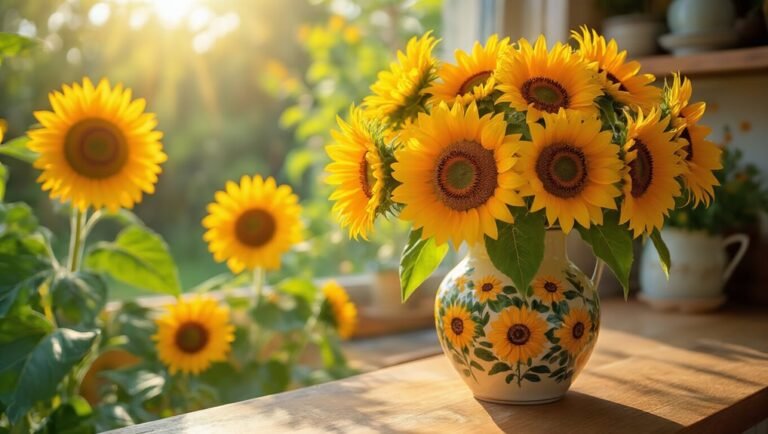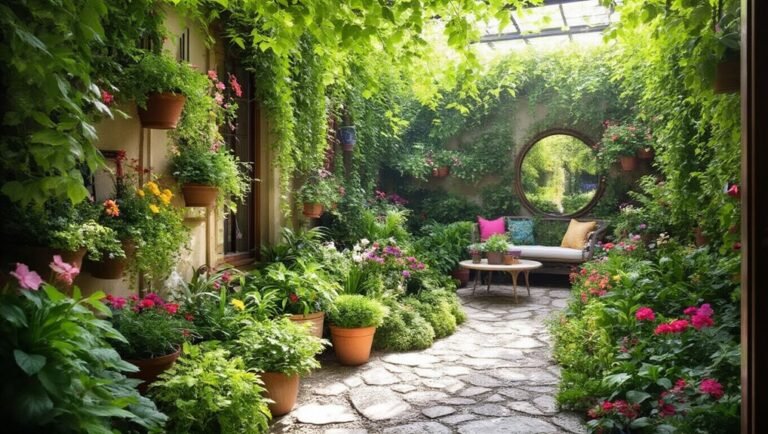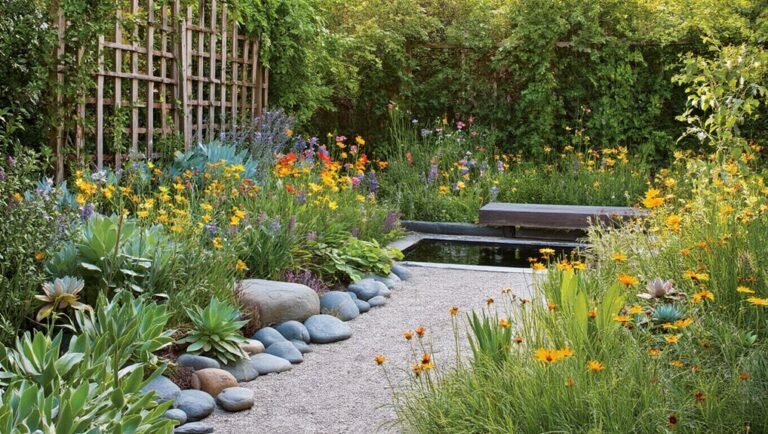For a polished look in your flower beds, consider these four edging ideas: Natural stone edging offers timeless beauty and prevents soil erosion, while sleek metal edging adds a modern touch. Brick or paver borders provide classic charm and clearly define spaces, and wooden edging gives a warm, organic feel that’s easily shaped. Each option enhances your garden’s aesthetics and functionality. Explore these choices further for the perfect fit for your landscape!
Key Takeaways
- Natural Stone Edging: Use granite or limestone for a timeless look that prevents soil erosion and enhances visual interest with uneven surfaces.
- Metal Edging: Opt for sleek, durable metal borders that maintain clean lines and easily shape to fit your garden’s design.
- Brick or Paver Borders: Create classic charm with brick or pavers that clearly define flower beds while preventing soil erosion.
- Wooden Edging: Choose treated wood for cost-effective, organic borders that can be easily shaped and provide a warm aesthetic.
- Combine Elements: Enhance your design by pairing your chosen edging with trellises or arches for added vertical interest and structure.
Natural Stone Edging
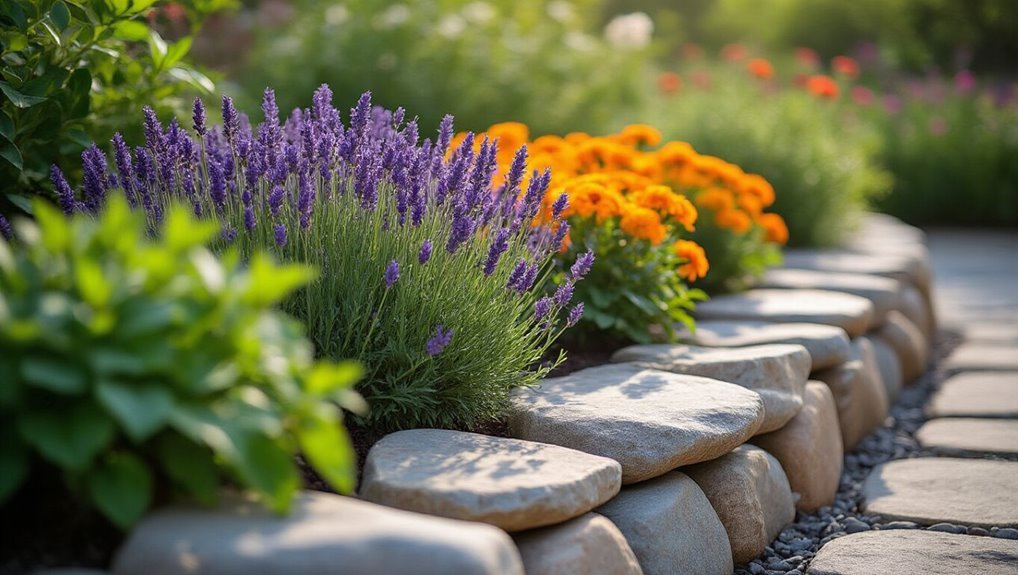
Natural stone edging can transform your flower bed into a stunning focal point. It adds a timeless, natural beauty that complements your plants while providing structure. You can choose from various stone types, like granite or limestone, allowing you to match the edging to your home’s style.
When you install natural stone, you create a durable barrier that helps prevent soil erosion and weeds. A key step in creating neat edges is using garden trowels to shape the soil and ensure the stones sit securely. Plus, the uneven surfaces of stones add texture and visual interest.
To install, simply dig a shallow trench, arrange the stones in your desired pattern, and fill gaps with soil or mulch. This method not only enhances your flower bed but also boosts your garden’s overall appeal.
Embrace this elegant option for a polished look!
If you’re considering natural stone, don’t forget the importance of edging tools to ensure precise placement and a professional finish.
Metal Edging
If you’re looking for a modern alternative to natural stone, metal edging can provide a sleek and contemporary touch to your flower beds. It’s durable, low-maintenance, and can be shaped easily to fit any design. Metal edging comes in various styles, allowing you to choose one that complements your garden aesthetic. For gardeners interested in supporting climbing plants or maximizing vertical space, Garden Trellis Netting is an excellent addition to your edging plans.
Here’s a quick comparison of popular metal edging materials:
| Material | Durability | Cost |
|---|---|---|
| Aluminum | High | Moderate |
| Steel | Very High | Higher |
| Galvanized | High | Moderate |
| Corten Steel | High | Higher |
When you opt for metal edging, you create clean lines that enhance your garden’s overall appearance while keeping mulch and soil in place. For additional plant protection, consider pairing your edging with garden netting to safeguard your beds from pests and environmental stress.
Brick or Paver Borders
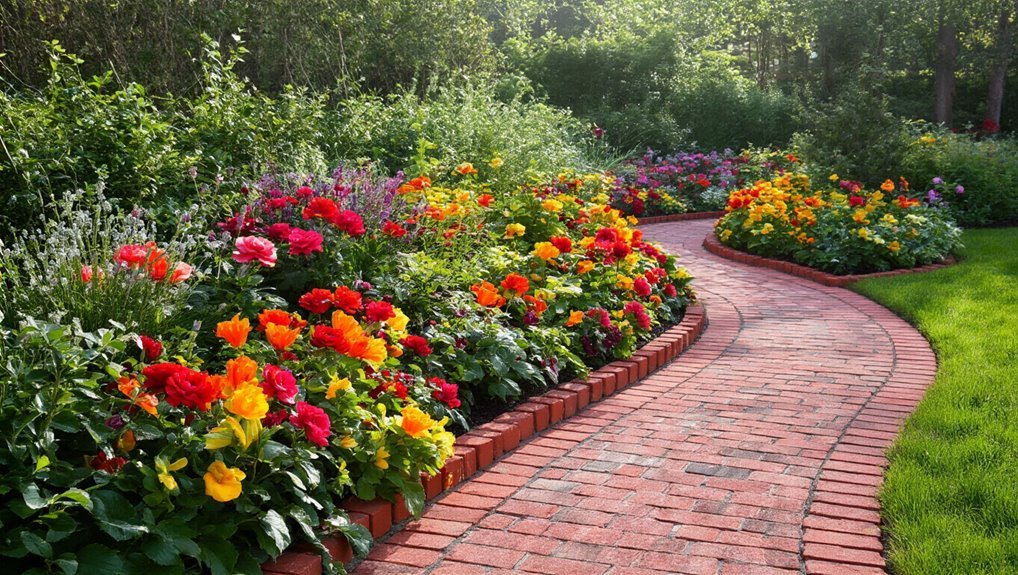
While metal edging offers a modern look, brick or paver borders bring a classic charm to your flower beds. These materials not only enhance your garden’s aesthetic but also provide durability and structure.
You’ll find that they can:
- Define your flower beds clearly, creating a neat and tidy appearance.
- Prevent soil erosion, keeping your plants healthy and secure.
- Offer various design options, from rustic to contemporary styles.
Installing brick or paver borders is straightforward, allowing you to customize the shape and layout of your garden. For added vertical interest and plant support, consider incorporating garden trellises alongside your borders for a cohesive and attractive landscape.
With a little creativity, you can create a stunning focal point that enhances your outdoor space. Plus, their timeless appeal ensures they’ll complement any garden design, making your project truly stand out. For even more dimension and elegance in your landscape, consider pairing your edging with garden arches to frame pathways or entrances as a beautiful focal point.
Wooden Edging
For those seeking a warmer, more organic touch, wooden edging offers a fantastic alternative to brick or paver borders. You can use treated timber, cedar, or even reclaimed wood to create a natural look that complements your garden’s aesthetic.
Wooden edging is versatile, allowing you to shape it easily to fit any flower bed design. Additionally, it’s cost-effective and can be installed with minimal tools. Just ensure you treat the wood to withstand moisture and pests, prolonging its lifespan. When installing or maintaining wooden edging, wearing the right gardening shoes can help keep you comfortable and protected throughout the process.
You might also consider using logs or branches for a rustic feel. With proper care, wooden edging enhances your garden while providing a clear boundary for your flower beds, making them stand out beautifully.
For even greater versatility and structure in your garden, consider incorporating raised garden beds alongside your wooden edging for an elevated planting experience.
Frequently Asked Questions
How Do I Maintain Flower Bed Edging Materials?
To maintain your flower bed edging materials, regularly check for wear and tear, clear debris, and ensure proper alignment. You should also reapply mulch as needed and replace any damaged sections to keep it looking fresh.
Can I Use Multiple Edging Types Together?
Yes, you can mix multiple edging types for a unique look. By combining materials like stone, wood, and metal, you create visual interest while maintaining functionality. Just ensure they complement each other and suit your garden’s style.
What Is the Best Height for Flower Bed Edging?
Imagine you’ve got a vibrant flower bed. The best height for edging typically ranges from 4 to 6 inches. This height effectively defines the space while preventing soil erosion and keeping weeds at bay.
Are There Eco-Friendly Edging Options Available?
Yes, you’ve got eco-friendly edging options! Consider using materials like reclaimed wood, bamboo, or natural stones. These not only enhance your garden’s look but also contribute positively to the environment while keeping your flower beds neat.
How Can I Prevent Weeds With Edging?
Imagine a vibrant garden, free from pesky weeds. You can prevent them by installing sturdy edging that creates a barrier, allowing only your beautiful blooms to flourish while suffocating unwanted growth beneath the soil’s surface.
Conclusion
Incorporating professional flower bed edging not only enhances your garden’s beauty but can also boost your property value. It’s said that well-defined edges create a sense of order, making your outdoor space more inviting. Whether you choose natural stone, metal, brick, or wood, each option brings its own charm and practicality. So, go ahead and experiment with these ideas—your flower beds deserve the best, and you might just discover a newfound passion for landscaping along the way!
